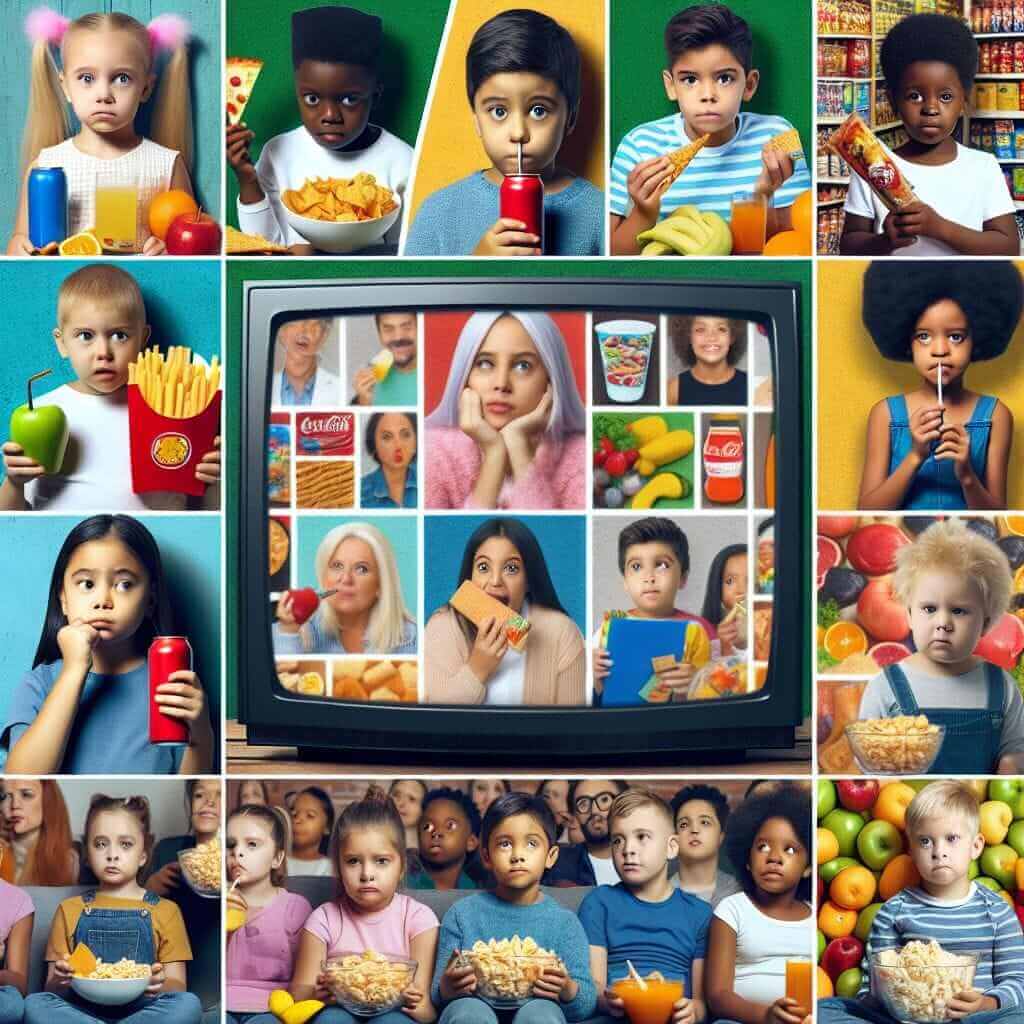Understanding the implications of food advertising on children is critical for public health initiatives. In the IELTS Reading section, you may encounter passages examining diverse topics, including the effects of food promotion. This article centers around a passage that scrutinizes the impact of food advertising on children’s food knowledge, preferences, and behavior.
Actual IELTS Reading Passage
Review of Research on the Effects of Food Promotion to Children
This review was commissioned by the Food Standards Agency to examine the current research evidence on:
- the extent and nature of food promotion to children
- the effect, if any, that this promotion has on their food knowledge, preferences, and behavior.
Paragraph A
A. Children’s food promotion is dominated by television advertising, primarily promoting pre-sugared breakfast cereals, soft-drinks, confectionery, and savory snacks. Recently, fast food advertising has increased. Although television remains crucial, global branding now requires multi-faceted communication, including merchandising and point of sale activity. The advertised diet contrasts with public health recommendations, focusing on fun and taste rather than health, with minimal promotional support for recommended diets.
Paragraph B
B. Evidence shows children notice and enjoy food promotion. The review explores its influence on children’s food knowledge, preferences, behavior, and health outcomes like obesity. Advertising marginally affects children’s general understanding of a healthy diet but can influence specific nutritional knowledge; for example, seeing soft drink and cereal ads reduced primary-aged children’s ability to identify real fruit content correctly.
Paragraph C
C. Studies show food promotion influences children’s food preferences and their purchasing behavior. Primary school children’s exposure to advertising affected their claimed likes, and vending machine signage impacted secondary school pupils’ purchases. Advertising can also sway children’s eating behavior, like primary students’ snack choices at playtime.
Paragraph D
D. Establishing a link between food promotion and diet or obesity is difficult, requiring real-world research. Studies using television viewing as a proxy have shown links between TV viewing, diet, obesity, and cholesterol levels, but it’s unclear if this is due to advertising, sedentary viewing habits, or concurrent snacking. Detailed diaries showed the more food adverts children saw, the more calories they consumed.
Paragraph E
E. Literature indicates food promotion affects children’s diets, although proof is elusive. Not all studies concur, and few measure these effects’ strength relative to other factors like parental eating habits. However, many studies show clear, sophisticated methodology-confirmed effects not attributable to chance or other factors.
Paragraph F
F. Two factors suggest food promotion’s influence on children might be understated. Focused mainly on television, the cumulative effect combined with other marketing forms could be greater. Also, studies look at direct effects, possibly underestimating indirect influences, like affecting parents to normalize fast food habits.
Paragraph G
G. While this doesn’t constitute definitive proof, it provides substantial evidence of an effect. The debate should now shift to utilizing commercial marketing power to improve young people’s eating habits.

Reading Questions and Answers
Headings for Paragraphs
Choose the most suitable heading for paragraphs A-G:
- Paragraph A: viii (Advertising’s focus on unhealthy options)
- Paragraph B: ii (How much children really know about food)
- Paragraph C: vi (Evidence that advertising affects what children buy to eat)
- Paragraph D: v (Connection of advertising and children’s weight problems)
- Paragraph E: i (General points of agreements and disagreements of researchers)
- Paragraph F: x (Underestimating the effects advertising has on children)
- Paragraph G: iii (Need to take action)
Statements Verification
Determine if the following statements agree with the views in the passage:
- There is little difference between the number of healthy food advertisements and the number of unhealthy food advertisements.
- Answer: NO
- TV advertising has successfully taught children nutritional knowledge about vitamins and others.
- Answer: NO
- It is hard to decide which aspect of TV viewing has caused weight problems of children.
- Answer: YES
- The preference of food for children is affected by their age and gender.
- Answer: NOT GIVEN
- Wealthy parents tend to buy more “sensible food” for their children.
- Answer: NOT GIVEN
- There is a lack of investigation on food promotion methods other than TV advertising.
- Answer: YES
Common Mistakes in this Type of Reading Task
-
Misinterpreting the Question: Carefully read what the question asks. Ensure you’re not proving the statement but whether the author agrees.
-
Overlooking Context: Note the context in which a fact is mentioned. Context is crucial for understanding the writer’s stance.
-
Ignoring Keywords: Identify and match keywords from the questions to the passage to find precise answers.
-
Guessing Uncertainly: If unsure, mention ‘NOT GIVEN’ rather than guessing a YES or NO inaccurately.
Difficult Vocabulary
- Commissioned (verb) /kəˈmɪʃənd/ – Officially ordered or authorized.
- Cumulative (adjective) /ˈkjuːmjʊlətɪv/ – Increasing by successive additions.
- Proxy (noun) /ˈprɒksi/ – Authority to act for another or something used to represent something else.
Challenging Grammar Structures
-
Passive Voice: Used for objectivity. Example: “This review was commissioned by the Food Standards Agency.”
- Structure: Subject + auxiliary verb (be) + past participle.
-
Relative Clauses: Provide additional information. Example: “Studies using television viewing as a proxy…”
- Structure: Clause introduced by relative pronouns (which, that).
Understanding such grammar structures can help better comprehend and answer IELTS reading passages relevantly.